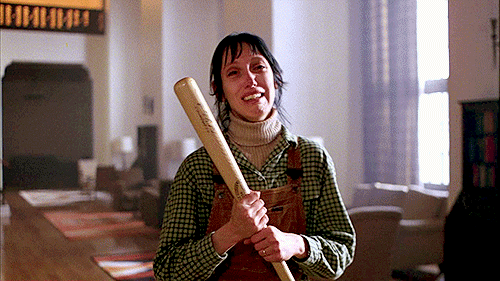 When Stephen King sold the film rights to The Shining, he imagined a cheerleader blonde-type playing the role of Wendy Torrance. A woman who couldn’t see evil coming her way because she had never faced hardships before in her life. That didn’t mean that King’s Wendy was some sort of second-rate victim – in the novel, she was tough, driven and equal to her husband, Jack. Something very far from what actually ended up in Stanley Kubrick’s 1980 interpretation.
When Stephen King sold the film rights to The Shining, he imagined a cheerleader blonde-type playing the role of Wendy Torrance. A woman who couldn’t see evil coming her way because she had never faced hardships before in her life. That didn’t mean that King’s Wendy was some sort of second-rate victim – in the novel, she was tough, driven and equal to her husband, Jack. Something very far from what actually ended up in Stanley Kubrick’s 1980 interpretation.
King, who famously despises Kubrick’s adaptation, told the BBC that movie-Wendy is: “One of the most misogynistic characters ever put on film. She’s basically just there to scream and be stupid…that’s not the woman that I wrote about.”
Both King and actor Jack Nicholson wanted Jessica Lange in the role – a strong and fearless performer who could instill those very same qualities into the character. Think more “final girl” than “hapless victim.” However, Kubrick had other plans, choosing the delicate, doe-eyed Shelley Duvall for her emotional vulnerability and soft-spoken nature, which eventually translated on screen.
While Nicholson admitted to having a good working relationship with his director (total #bromance), Duvall could not say the same, as evidenced in the documentaries Making ‘The Shining’ and Stanley Kubrick: A Life in Pictures. Kubrick would often lose his temper with the actress, telling her she was wasting everyone’s time on set. He told the crew to give her no sympathy and to not praise her work, while continuously breaking her down and pushing her to her limits. He kept Duvall isolated, and made her perform the iconic baseball bat scene 127 times, entering the scene into The Guinness Book of Records as the most takes ever shot for a scene with spoken dialogue. Duvall’s shaking hands and puffy, terror-filled eyes were the result of actual distress.
“Have you seen the film Groundhog Day? Well, that’s what it was like,” Duvall commented.
Duvall was certainly not exaggerating. The scene towards the end of the film, where Wendy is running up the stairway carrying a knife, was shot 35 times; the equivalent of running up the Empire State Building. In addition, during an interview for a British network’s “100 Greatest Scary Moments,” Duvall revealed that because her role required her to be in an almost constant state of hysteria, she eventually ran out of tears from crying so hard and had to keep bottles of water with her at all times on set to remain hydrated.
“From May until October I was really in and out of ill health because the stress of the role was so great,” said Duvall in the book The Complete Kubrick by David Hughes. “Stanley pushed me and prodded me further than I’ve ever been pushed before. It’s the most difficult role I’ve ever had to play.”
The actress cites her time on The Shining as some sort of primal scream therapy. In 1980, when asked by Roger Ebert about her time on the film, she said it was: “Almost unbearable…But from other points of view, really very nice, I suppose…After the day was over and I’d cried for my 12 hours, I went home very contented. It had a very calming effect.”
Did her experience on The Shining turn her off to acting all together? Some say yes, though it’s really all hearsay. Since 2000, Duvall only has three acting credits to her name, though she did consistently work up until that point. Though to be fair, after having time to regroup and gain some hindsight, Duvall was quoted saying: “I might have hated him at the time, but I now see him as a really important filmmaker who gave me the role of my life and made me the sort of actress I never dared think I’d become.“
Possessed, psychopathic husbands be damned, it still seems Duvall’s shooting experience with Kubrick is the real horror story behind The Shining.



“I might have hated him at the time, but I now see him as a really important filmmaker who gave me the role of my life and made me the sort of actress I never dared think I’d become.“
Stockholm Syndrome much? Great post, love this, thanks bruh.
I heard about this before. Acting is hard work.